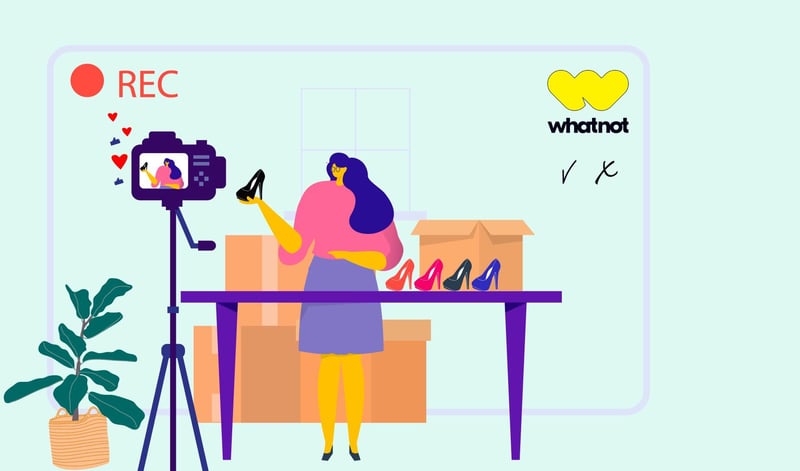Live selling is taking over with Whatnot auctions! With video, especially live video, dominating social media today, it’s no surprise that reselling platforms would eventually hop on this hot trend. Some pioneering resellers caught on early and started live selling on their own using Instagram Live. Now dedicated apps are popping up that help streamline the process of hosting live sales.
Whatnot, a platform built intentionally for live selling, entered the scene and set the trend on fire throughout the reselling community. Now it seems like everyone wants in on the action from Poshmark to Etsy. So, what is live selling, and how do you know if it’s right for your business?
Vendoo breaks down the pros and cons of live selling on Whatnot so you can make an educated choice.
What Is Live Selling?
In traditional online reselling, you will present your buyer with images and a description. Your closet is “open” 24 hours a day, and using messaging and offer buttons; transactions can be carried out at any time. In live sales, you set a specific time for your audience to “attend” a sale, and you will be live on video showing and describing your items. Live sales are typically auctions, and the fun comes in when the bidding starts!
While traditional online selling is perfect for people that like to stay behind the camera, live sales allow resellers to host their own mini-TV shows and let their personality shine. The thrill of bidding can become addictive to the audience, which is why live selling has become so popular.
Live-selling platforms will charge a fee for sales you make, but here is what they offer you in return:
-
A way to run auctions digitally through the app that makes it transparent, fair, and easy to track
-
A way to run giveaways (Whatnot) to attract buyers
-
A list of sales and shipping labels after the show is over
-
A way to schedule and promote shows in advance
-
Some customer service for issues that could arise after the sale
-
Discounted shipping
Besides having to become a mini-reality TV star, the main complaint traditional sellers have is the price point many items are sold at. High-volume, low-profit sales aren’t for everyone, but they make up a large majority of these live sale auctions.
There are two types of buyers who enjoy live auction-based sales. The first type of buyer is looking for elusive or rare items, and they are willing to pay a lot of money for them. This is especially relevant right now in the vintage t-shirt market. People will pay a premium for vintage deadstock, genuine concert shirts, and other hot items. The second type of buyer is looking for deals and steals. They are hoping to snag everyday items for a much cheaper than normal cost.
What you sell, what inventory you have access to, and what business model you choose will determine which type of buyer you want to cater to.
Looking to boost sales? Check out our guide to Top Rated Online Marketplaces
Is Whatnot A Legitimate Way To Make Money?
Whatnot is a legitimate selling platform that many resellers use to make their full-time or part-time income. Whatnot started in 2019 as a live selling platform for selling Funko Pop collectibles. Eventually, they added more categories such as sports trading cards, comics, and eventually fashion and estate sale items. While sports cards are currently their most popular category, fashion and home decor items are trending as well.
The benefit of using Whatnot as your live-selling platform is that live-selling is their main focus. This means that most of the kinks in live auction-style selling have been worked out, and processes are dedicated to making a smooth transaction from start to finish. Sellers also have to apply and be accepted, as well as attend an onboarding training session before they can sell. This makes sure that buyers have a good experience and also helps Whatnot control how many sellers they have per category at a time.
Whatnot has really expanded what you can sell over the last year. Here are just some of the popular items you can sell on Whatnot right now:
-
New Fashion
-
Secondhand / Thrifted Fashion
-
Jewelry
-
New or Secondhand Accessories
-
Vintage or Estate Sale Finds
-
Sports Cards
-
Shoes (New, vintage or secondhand)
-
Funko Pops, Hot Wheels, Or Other Toys and Collectibles
-
Comics / Manga
-
Video Games
-
NFTs
-
Coins
-
Music
-
Books
-
Health / Beauty
-
Food and Drink
-
Home and Garden
-
Sports Equipment
-
Return Pallets
-
Arts / Crafts (handmade)
-
Disney
-
Crystals
For more information on this platform, you can read our in-depth guide: Whatnot App: A Guide For Sellers and Buyers.
Is Live Selling Right For My Business?
Live-selling sounds like fun, but how do you know if it’s time to take the leap and try your hand at it? Like all trends, it’s hard to tell how long they are going to last. Is live selling here to stay, or will the novelty fade in time? It’s difficult to predict, but here are a few points to consider:
- We got hooked on live selling during the pandemic and the pandemic aftermath. Many people were off work or working from home with more time on their hands than usual to spend on their phones watching live-selling shows. As things go back to our “new normal,” it will be interesting to see if live sales can survive.
- The most efficient way for a buyer to shop is to go to a search bar and type in exactly what they want (traditional selling). It’s not a great use of someone’s time to sit through hours of live shows just in case something pops up in the size that they want. So when the fun wears off, will live sales still be a competitive way to move inventory?
- Video, especially live video, is becoming more popular each year. It’s possible that live selling will continue to be popular just because people would rather watch live sales on their phones than scroll static photos and posts or watch streaming TV that isn’t as interactive.
For some sellers, it’s worth it to change up their business model to include live selling while it’s hot, even if they feel like it’s a passing fad. Other sellers would rather stick with proven processes and let the live selling trend pass them by. It’s possible to make money from live-selling, and it’s possible to keep making money with traditional reselling. That’s the beauty of online selling; there’s a business model out there for everyone.
Did you know you can list to Whatnot's marketplace with Vendoo?
The Pros And Cons Of Live Selling On Whatnot
Still trying to decide if live sales are right for you and your business? Grab your pen and paper; it’s time to make a pros and cons list! Looking at the positives and negatives side-by-side can give you a better understanding of the entire situation.
The PROS of live selling:
-
Interactive experience
-
Fun and high-energy
-
Make FAST sales (quick flips)
-
Sell a high volume
-
Create a process of low-cost sourcing and high-volume shipping to save time
-
Use your marketing or social media skills to promote shows
-
Platforms like Whatnot make running auctions easy
-
Trendy - might not last forever, so ride the wave!
The biggest “pro” to live selling is the ability to sell 20, 30, or more items in a single show with just a few hours of work. While you won’t fetch top-dollar for most items, it’s a great way to flip fast without having your money tied up in inventory. You also don’t have to spend as much time listing the item as Whatnot listings aren’t as detailed as other reselling platforms.
People with sparkling personalities who have access to a high volume of extremely low-cost items (like pallets or thrift outlets) will stand to make the most money and be most successful with live selling.
Don't miss out on boosting your online sales – Grab your copy of Vendoo's Ultimate Marketplace Guide for Resellers today!
The CONS of live selling:
-
Interactive and high-energy (Yes, this is on both lists! Everyone has their own personality, and live selling might not be as fun for introverts as it is for extroverts)
-
Lower profits per sale. Live selling is certainly more of a “fast nickel” sales model; you will sell in volume but at a lower cost (unless you have hot “grail” items)
-
Auctions are a risk - you could end up selling an item much lower than you wanted to
-
You have to do some marketing to build your audience
-
Not passive income, you have to plan, market, and perform at a scheduled time
The main “con” that will turn resellers away from the idea of live selling is having the desire to be the host of your own TV show. Not everyone loves to be on camera; some will find it very uncomfortable. While some live sellers don’t show their faces, the best shows usually feature a host enjoying the limelight. In fact, some shows feature hosts that are so charismatic that people are over-bidding on items just to own something from that seller.

Who Can Apply To Be A Live Seller?
Right now, all of the online selling platforms have some sort of invitation or application process. This is to try to help control market oversaturation and also to make sure sellers have a good experience when watching live shows.
In order to make sure your application goes through, here are a few things to consider. Present yourself in a professional manner. Double-check your application for spelling and grammar. Use your business branding or name if applicable.
The application will ask what you primarily want to sell and how you source your inventory. They want to see if you have a process in place for replenishing inventory, so they know you will be selling with them for a while. If they ask for photos or videos of your current inventory, make sure to put your best stuff out front and present clear images.
If you have a social media presence, make sure to let them know, as that can actually be a big factor in their decision. These platforms desperately need to bring in new buyers, so if they think you can help them do that, you’re going to stand out.
If you don’t hear back right away, it’s alright to follow up but again, be patient and professional in all communication. Also, make sure that you will be available for any interviews or live-training sessions that you might require.
About The Whatnot App: Unique Insights and Perspectives on Whatnot's Success and User Behavior:
1. Livestreaming as a Shopping Experience:
- Engaged Audience: Whatnot leverages the power of live streaming to create an interactive and engaging shopping experience. Unlike static product listings, live auctions and streams foster a sense of community and excitement, driving participation and bids.
- Expert Hosts & Entertainment: Hosts play a crucial role in Whatnot's success. Their product knowledge, storytelling ability, and charisma create an entertaining experience that goes beyond just bidding.
- Discovery & Gamification: The platform's curated auctions and gamified elements like leaderboards and challenges encourage exploration and discovery, leading to impulse purchases and increased engagement.
2. Building Community & Trust:
- Focus on Authenticity: Whatnot emphasizes authenticity in its products and interactions. This attracts collectors seeking genuine items and fosters trust within the community. (Source: Forbes: Whatnot's CEO on Building a $1 Billion Business By Selling Authenticity: [invalid URL removed])
- Social Interaction & Shared Interests: The platform facilitates direct interaction between buyers, sellers, and hosts, fostering a sense of community around shared interests. This builds loyalty and encourages repeat engagement. (Source: a16z: Whatnot: Transforming Collectibles Through Live Commerce: [invalid URL removed])
- Targeted Content & Curation: Whatnot personalizes content and recommendations based on user interests, creating a more relevant and engaging experience that drives deeper engagement.
3. Mobile-First & Frictionless Experience:
- Seamless Mobile Experience: Whatnot prioritizes a mobile-first approach, making the platform accessible and convenient for users on the go. This caters to the growing trend of mobile shopping and impulsive purchases.
- Simplified Payment & Checkout: The platform offers a seamless and secure payment process, minimizing friction and encouraging impulse buys during live auctions.
- Fast & Efficient Auctions: Whatnot's auction format is fast-paced and efficient, keeping users engaged and minimizing the time commitment for participation.
Where Can Resellers Host Live Sales?
Whatnot is one of the most popular places to host live sales, but it certainly isn’t your only option. Right now, you can also host live sales on Poshmark, which launched its beta live sale program earlier this year. You can also arrange your own live sales on Instagram Live or any social media platform that offers live video.
Pros and Cons of “Posh Shows” Poshmark’s Live Selling Program:
A few months ago, Poshmark launched a beta version of their own live-selling feature. It started with a small group of invite-only sellers. With a small pool of sellers, the shows were well attended (some either upwards of 300 or 400 people in attendance) and usually sold out at high-profit points. However, as soon as Poshmark started allowing more sellers, the market quickly became flooded, and you will now see shows with as few as 3-6 people in attendance. Some resellers with a gift for entertaining are still bringing in larger audiences though.
The “pros” of selling live on Poshmark include having access to your already listed items saving you time prepping for your shows, and having an audience built into the app who are looking mostly for fashion and home decor items. You can also seem to get away with higher starting prices on Poshmark than you can on Whatnot.
The “cons” of selling live on Poshmark include the high shipping costs (even after the new but clunky bundling feature for multiple live sales), a flooded market with 30+ shows going on at once, and a lack of rules or guidance that causes some questionable content to be shown. For example, users have a theory that going live boosts your closet in the algorithm (unproven), so they are “going live” without actually selling anything. Sometimes they will simply have their camera on with a note and nothing else going on to try to cheat the system. Hopefully, these rules will get ironed out in time as this is a beta program.
You can learn everything you need to know about Posh Shows on our blog post, “Posh Shows Come To Poshmark!”
Pros and Cons of Live Selling On Your Own Using Instagram:
Long before live-selling apps became a thing, people had discovered they could host live online sales using IG Live. These sales were generally not auctions, but sellers would offer good deals and show off the products live. The shows would usually be a lot of fun with giveaways, costumes, music, and other entertainment. Since you don’t have an online selling platform structuring your event, however, you will be in charge of tracking sales, picking shipping methods, and making sure you get payments via Venmo, Paypal, or some other method.
The “pros” of hosting your own live sales include the freedom to have your own rules, not having a lot of competition, and not having to risk losing money on an auctioned item.
The “cons” of hosting your own live sale include having to organize and track sales on your own, having to handle generating your own shipping labels, and making sure customers pay after the sale.
Now other reselling platforms such as eBay and Etsy are working on beta versions of live selling as well. More live-selling apps like Whatnot are also starting to make headlines, including one called Jamble, which calls itself an online live-thrifting app and seems to be a combination of TikTok and Whatnot.
You might also like: 11 Great Marketplaces Every Reseller Should Consider
Tips To Make More Sales On Live Reselling Platforms
In order to make sure you have sold-out shows that fetch a decent price per item, you need to have as large of an audience as possible. If your show only has a handful of people in it, then bidding wars are unlikely to ensue, and it can be hard to move any inventory at all.
Tips To Gather A Larger Live Sale Audience:
-
You’ll want to schedule your shows in advance. It helps to have a consistent schedule too, such as every Wednesday night at 8 PM. Having the shows set up in advance will make it easier to market. Your followers can also bookmark future shows they want to attend and get reminders on both Whatnot and Poshmark.
-
Spend time on the app, attend other people’s shows, and be active in the community. This will encourage people to follow you. Followers get notified when you go live.
-
Use social media, blogs, or e-mail newsletters to market your shows outside of the selling platform. This isn’t Field Of Dreams; just because you schedule a show doesn’t mean people will come. It’s up to you to spread the word!
-
Advertise a giveaway to get people excited about your show.
-
Have a theme. Remember, people don’t want to sit for hours waiting for an item they like to hopefully appear. Themed shows will help qualified buyers show up, such as plus-size shows, sweater shows, just shoes, and other themes.
Once you have scheduled your show and marketed it, it’s time to go live! Remember that live selling is just as much about trusting and enjoying the host as it is about the items being sold.
Here are eight tips that have helped successful live sellers make money:
-
Be yourself! Being relaxed will help you be more likable, and if you’re having fun, then your audience will have fun too.
-
Don’t be afraid to make jokes, be silly, and just have fun with the whole process.
-
Make sure you talk to your audience and respond to comments live. It also helps to assign a friend to be a “moderator” in the chat. A moderator can answer basic questions while you are showing off your inventory.
-
Be prepared. It’s boring to watch a host try to organize their inventory in the middle of a show or spend 10 minutes looking for an item. Do your organization off-camera before the show starts.
-
Make sure you know all the rules of the platform and how things work. You’ll get asked questions about shipping, returns, fees, and just about everything else during your show by newbie buyers.
-
Have some music playing to set the mood.
-
Some sellers have had luck with giveaways or fun games during their live shows. These things cost money and aren’t 100% necessary for success, but they certainly help. An example of a game would be entering their name in a drawing every time they make a purchase or letting them select a mystery prize if they make a purchase over a certain dollar amount.
-
And finally, build a solid reputation as a professional seller. This means being honest in your item descriptions, following all platform rules, shipping quickly and in proper packaging, and answering customer questions or complaints using your very best customer-service smile.
Whatnot Reviews From Sellers & Buyers



(via trust pilot)
With these tips in mind, anyone can have success with live selling. The best way to know if live sales are right for you is to give them a try! If you have enough inventory, apply to be a seller and host at least one show a week for a month. This should give you plenty of experience to see if it’s something you want to keep pursuing.
Join thousands of resellers crosslisting to Whatnot with Vendoo!
If you do try live sales, drop us a quick comment to let us know how it went!








